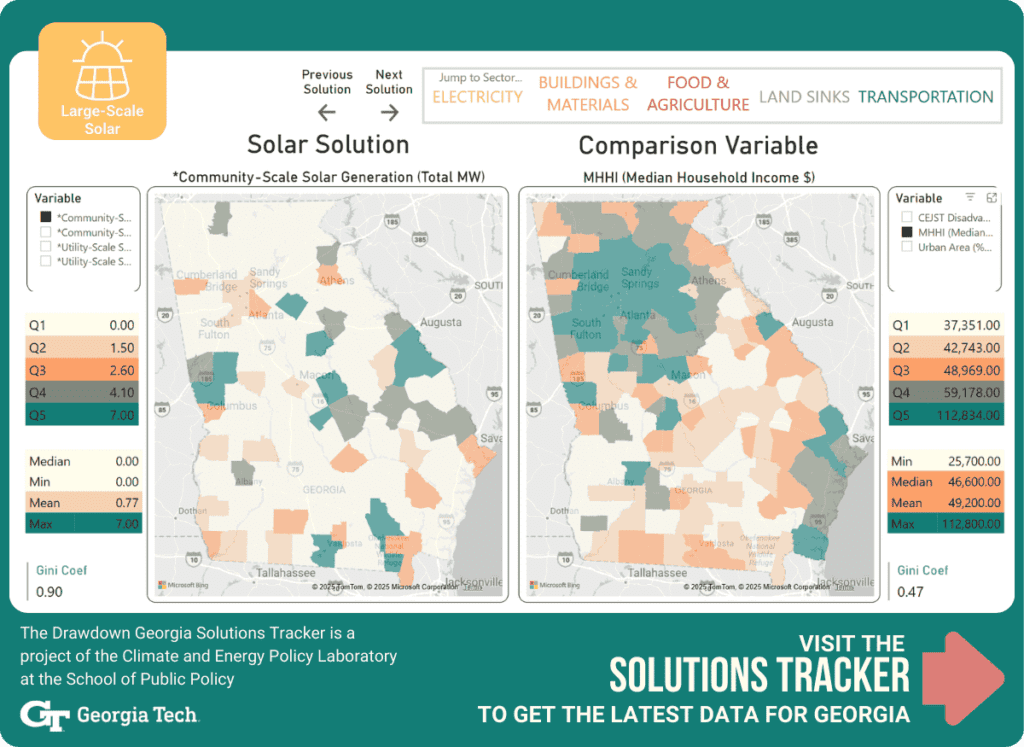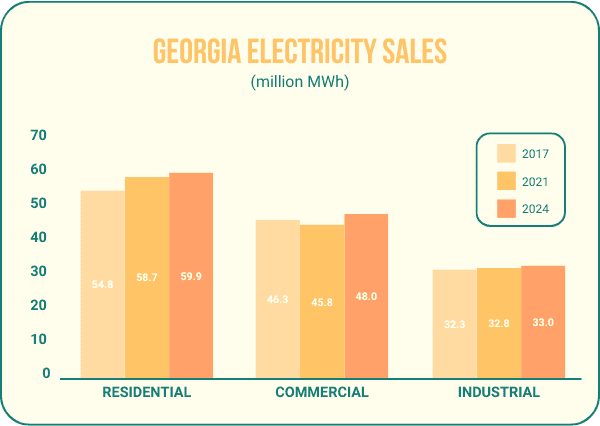The Benefits of Large-Scale Solar
Solar photovoltaic systems convert solar energy into clean, renewable electricity. Large-scale or utility-scale solar is defined as any ground-mounted solar panel structure with a capacity rating larger than 5 MW.
Community solar projects range from a few hundred kW to a few MW on the distribution grid and are typically administered by the utility or a third-party entity so that multiple customers can participate. This solution also considers the possible advantage of on-site battery storage to enhance reliability.
Access Large Scale Solar Resources from Drawdown Georgia
Market Readiness And Available Technology
The technology is mature and market-ready. Utility-scale solar is growing rapidly worldwide, and costs have been declining. Large-scale solar in Georgia has experienced unanticipated levels of significant investment.

Based on the Georgia Tech National Energy Modeling System (GT-NEMS) 2018 baseline scenario, Georgia was estimated to have a large-scale solar capacity of 0.6 GW by 2022; this has now been far exceeded and stands at 4.1 GW by the end of 2023. In 2022, about 6% of our state’s electricity came from solar, almost all produced by large-scale installations. Nationally, 65% of solar energy is produced by utility-scale installations.
One of the key drivers of this deployment has been tax credit provisions – the Income Tax Credit and Production Tax Credit – received by taxpayers generating renewable energy. The Income Tax Credit was expected to diminish incrementally after 2019 and end in 2024, while the Production Tax Credit was expected to expire by the end of 2020. However, the Inflation Reduction Act was extended through 2024 and then converted to a technology-neutral Clean Energy Production Tax Credit with similar provisions.
Large-Scale Solar as a Climate Solution in Georgia
The Drawdown Georgia research team estimates that Georgia could reduce emissions by one megaton (Mt) of CO2e by adding ten new 100-MW utility-scale solar installations and 36 new 5-MW community solar projects.
What is the Carbon Emissions Reduction Potential by 2030?
Achievable reduction potential is derived by taking the technical reduction potential, outlined below, and developing a more realistic forecast that takes current rates of deployment, market constraints, and other barriers into consideration.
For large-scale solar, the Drawdown Georgia research team has calculated the achievable reduction potential to be 4.29 Mt of CO2e.
What Is the Upper Limit of Carbon Emissions Reduction Potential?
Technical reduction potential reflects the upper limit of emissions reductions for this solution without regard to the constraints that exist in the real world, such as economic or political considerations.
For large-scale solar, the Drawdown Georgia research team has calculated the technical reduction potential to be 21.4 Mt.
Progress on Large-Scale Solar in Georgia
In addition, Georgia’s Public Service Commission approved 2,100 MW of new large-scale solar in its 2022 Georgia Power Integrated Resource Plan. A report from the Solar Energy Industries Association and Wood Mackenzie ranks Georgia second nationwide for most solar manufacturing, with manufacturers Suniva, Qcells, and Adion Solar representing 21% of the U.S. market. The report also ranks our state fifth in the nation in solar installation, with 1.3 gigawatts of solar capacity in 2024--more than double the amount in 2023.
Sites for 500 MW of new battery energy storage capacity (BESS) projects, which were called for in the 2023 Integrated Resource Plan (IRP) update, have been identified by Georgia Power; all share solar generation infrastructure to reduce costs and speed deployment, such as the Hammond BESS project, which is located on the site of a former coal-fired power plant in Floyd County. Storage systems like these can help optimize grid utilization and improve energy management times of peak demand.
The 2025 IRP significantly increases Georgia Power's planned renewable procurements due to stronger-than-expected demand from corporate sustainability initiatives and economic development projects. Georgia Power plans to issue a 2026 Utility-Scale RFP targeting 1,000 MW of new renewable energy capacity, with an option to procure an additional 3,000 MW if customer subscription demand justifies it.
However, due to significant projected load growth of 8,205 MW through 2030-2031, this increase in renewable solar production will not offset the increase in natural gas generation, causing the anticipated decline in Georgia's electricity emissions to stagnate.
How Reliable Is Our Estimate For This Drawdown Georgia Climate Solution?
We estimate the total technical potential for rural utility-scale solar farms in Georgia to be 3,088 GW and 5,492,000 GWh, covering 64,343 km. The additional technical potential for urban utility-scale solar that might be suitable for community projects totals 24 GW and 43,167 GWh, covering 506 km.
These estimates exclude sites with slopes over 3%, <0.4 square miles of contiguous area, and wetlands, Federal parks, wilderness areas, wildlife areas, and many other incompatible land uses. Based on these estimates, only 16 states are estimated to have higher technical potential than Georgia. According to the Solar Energy Industries Association (SEIA), Georgia is ranked 20th nationwide for its potential for future growth. Georgia’s solar resource of 4.5-5.0 kWh per square meter per day is slightly less than that of Florida.
The Georgia Power 2019 IRP called for 2,000 MW of new utility-scale solar by 2022. This would displace 1.36 Mt CO2 in 2030. GT-NEMS forecasts that solar farms in Georgia will grow from 11,600 GWh or 7.9% in 2020 to 12,800 GWh or 8.9% in 2030 (Source: GT-NEMS modeling). This growth would displace 0.47 Mt CO2 in the year 2030.
To displace an additional 1 Mt CO2 will require 2,580 GWh of additional solar generation. At a capacity factor of 25%, this would require 1,178 MW of new capacity, or 10 additional 100 MW solar farms and 36 additional 5 MW community solar projects. The total of these two estimates is a technical potential of 5,535,000 GWh from utility-scale solar. This could displace 2,145 Mt CO2, which is more than 10 times the current greenhouse gas footprint of Georgia.
Challenges in Scaling Large-Scale Solar
While Georgia has rapidly expanded its solar capacity, challenges remain in ensuring equitable access to solar benefits across different communities. The state’s reliance on large-scale solar over rooftop solar means that the benefits of solar are not evenly distributed, as rural landowners and utility-scale developers capture most of the financial gains while urban consumers see limited direct cost savings.
While solar energy has driven emissions reductions, challenges related to intermittency, grid integration, and land use remain. Georgia’s reliance on natural gas for balancing variable solar output raises concerns about the long-term sustainability of emissions reductions. Policies that encourage hybrid solar-wind projects or increased battery storage deployment could further enhance the reliability of renewable energy in the state.
Economic factors, particularly the declining costs of solar and battery storage, are likely to continue driving expansion. However, market uncertainties, such as fluctuating natural gas prices and potential changes to federal incentives, may impact future growth. The continuation of state-level policy support, such as streamlined permitting processes and incentives for energy storage, will be crucial in maintaining momentum.
Cost Competitiveness
According to NREL, the national cost benchmark of utility-scale solar in Q1 2017 and Q1 2023 were the same at around $1.11/Watts direct current (Wdc).
However, the capacity-weighted cost for utility-scale battery storage fell from $755/kWh in 2017 to 476/kWh in 2023 and is projected to be at $117/kWh for systems deployed in 2028.
Georgia utility Southern Company is teaming up with Georgia Tech and Smart Wires on a new project backed by the US Department of Energy that will bring new technologies like advanced power flow control (APFC) and dynamic line rating (DLR) to the electrical grid in Georgia and Alabama, making it easier to integrate solar energy and more rapidly accommodate new demand.
Changes to Greenhouse Gas Emissions from Electricity Consumption
Electricity consumption from households in Georgia rose from 2017-2023. However, CO2 emissions from the electricity consumed by Georgia households dropped significantly, mostly due to reductions in the carbon intensity of the fuels used to generate electricity.


Beyond Carbon Attributes
The environmental and public health benefits of solar farms relate to air quality improvements from the reduction of fossil fuel pollution, particularly SO2 (a major contributor to acid rain), PM2.5 (a respiratory health concern), and NOX, in addition to CO2.
From an economic development standpoint, the construction and operation of solar farms offer local and statewide employment. According to the National Solar Job Census 2023, 250 solar companies are operating in Georgia. Between 2018-2023, Georgia experienced a growth rate of 52.6% in solar jobs, bringing the total solar employment in Georgia to 5,639. For many of the Drawdown Georgia Solutions, displacement of jobs from coal or other sources need to be considered/addressed against these positive economic benefits.
Despite its job growth potential, the solar workforce is currently not yet representative of America’s ethnic, racial, and gender diversity. Solar Jobs Census 2023 found that only 30% of the solar workforce was made up of women, and the racial breakdown is dominated by workers who are white, comprising 73% of the overall solar workforce.
Potential environmental costs may include the depletion of water resources due to solar panel cleaning (approximately 20 gal/MWh) and land use concerns about the displacement of native flora and fauna. While monitoring water use and seeking efficiencies are worthwhile endeavors, the use of water by solar farms is less intensive than traditional fossil fuel alternatives.
Large solar farms require significant land area, which can lead to habitat disruption and competing land-use concerns. Implementing best practices, such as co-locating solar installations with agricultural land (agrivoltaics) or prioritizing brownfield and reclaimed sites, can help mitigate these impacts. Solar farms in Georgia can produce 18.5 MW per square mile. Thus, 1 Mt CO2 reduction via solar farms requires about 64 square miles of land.
Potential impacts (both positive and negative) of intermittent solar generation on retail electricity prices are supported by mixed research findings. Similarly, the property-value impacts near utility-scale solar farms must be explored further.
Given the scale of current and potential solar panel installations, end-of-life disposability of PV panels is a relevant environmental issue due to toxic materials contained within the cell, such as cadmium, arsenic, and silica dust. The US is expected to produce 170,000 tons of PV panel waste in 2030.
In response to this problem, a new solar panel recycling industry is growing. The recycling company Solarcycle estimates it will be recycling 10 million solar panels per year by 2030 at a new Georgia facility, representing as much as 30% of all retired solar panels at that time.
Additionally, equitable access to solar remains a challenge. The Lorenz curve for community solar, coded by CEJST disadvantage levels, highlights the extreme inequality in the distribution of community solar capacity across Georgia.
What is the Gini Coefficient for Large Scale Solar?
With a Gini coefficient of 0.90, the curve reveals that community solar MW per 1,000 people is heavily concentrated among a small percentage of the population, while the vast majority of residents—especially those in disadvantaged communities—have little to no access.



